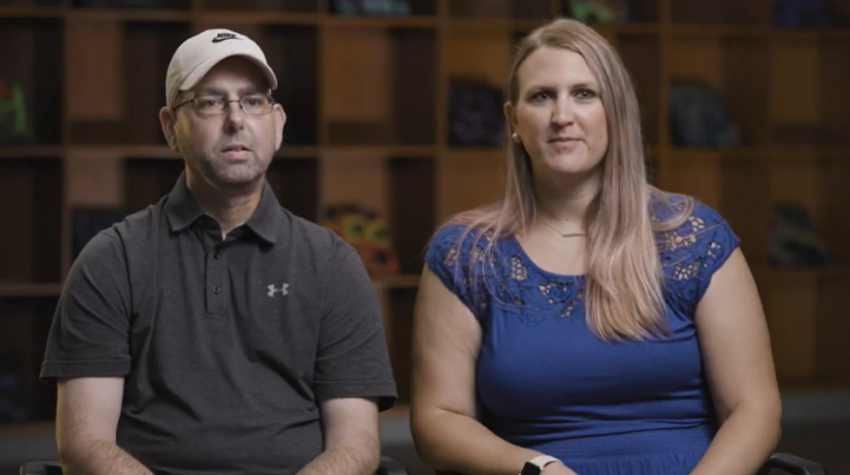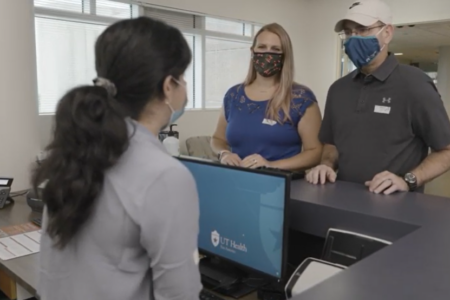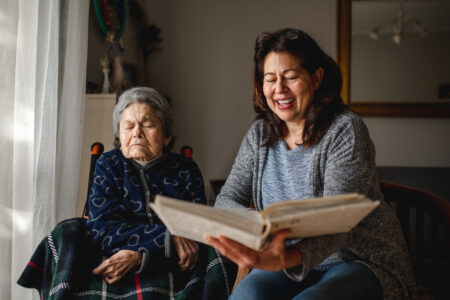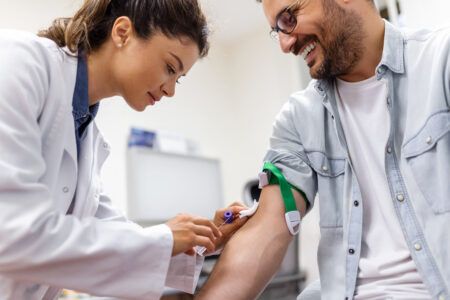
Share On Social!
Timothy Leech just celebrated his 40th birthday when he got news that changed his life.
Timothy was diagnosed with Stage 4 squamous cell carcinoma, a form of skin cancer, in 2014. Doctors told him he had only a short time to live.
“I freaked out, for sure. I thought I was going to be gone real quick,” Timothy said.
But, today, eight years later, Timothy is a cancer survivor.
He credits his wife, Katie Leech, his medical team, and a clinical trial for getting him to where he is today – not entirely cancer-free but “so small that it’s immeasurable.”
A clinical trial is a research study that helps researchers learn more to help slow, manage, and treat diseases like cancer.
“It was very much like, this [clinical trial] is the last roll of the dice here,” Katie said.
The Beginning of a Tough Battle with Cancer
After his diagnosis, Timothy began standard chemo and radiation treatments.
“He started off with chemo and radiation right off the bat,” Katie said. “We felt a sense of urgency to get started immediately.”
Timothy continued treatment for a while.
But it didn’t help like he expected.
“He had reached the max amount of radiation he can like ever have and it was just, ‘What else have you got for us?’ Like obviously these things aren’t working, now what?” Katie said.
Timothy then tried another type of immunotherapy.
But that didn’t yield positive results, either.
“The tumor was growing pretty aggressively again in a place where he had already had two brain surgeries. No, he had three brain surgeries, a double craniotomy, and another craniotomy, like all coming back in the same place,” Katie said. “So, it really was … well we’ve done this, and we’ve done this, unless you wanna go back to chemo, which he’d done it so many times at that point, I don’t think chemo was going to be on the table ever again.”
With treatment options running out for Timothy and his condition worsening, the couple began to worry.
The Last Resort: A Clinical Trial
Timothy’s medical team gave him one last option.
Enroll in a clinical trial. A trial is a research study performed in people to evaluate a medical, surgical, or behavioral intervention.
In Timothy’s case, the trial was evaluating a new treatment. Enrolling gave him hope.
“It was a lot of hoping and praying that we were gonna get to that point and that it was gonna work when we started. It was scary. It was very much like, this [clinical trial] is the last roll of the dice here. Like, if we don’t do this, I don’t know what we’re gonna do. So, we’ll do it.” Katie said.

The thing was, Timothy decided against doing any more chemo or radiation.
Since his diagnosis, Timothy had gone through radiation four times.
“He was at that point where he was like ‘I won’t do it, I’m done, I’m done I’m not gonna do it,’” Katie said. “He did not want anything that was going to give him all the chemo side effects anymore, that was what he was done with. No more mouth sores, no more feeing nauseous, no more not being able to swallow things. I mean he was done with all that, he did it all, he did It all a lot of times.”
So, the clinical trial option began to feel like a good fit.
“[Timothy’s medical team] got us in touch with the research coordinator and we talked to the [clinical trial team] and she laid it all out. We were very like, ‘We’ll do that for sure,’” Katie said. “So, I think just having the option there, it didn’t take a lot of convincing once we had something that was not gonna be the conventional treatments.”
Timothy viewed the clinical trial with confidence, and a small fear.
“I hate needles. Holy cow, that’s it though. I mean it just hurts a little bit. But other than that, nah, I’m not worried about anything, whatever happens, happens,” Timothy said.
Then it was time for the clinical trial.
“From everything we heard, [the clinical trial] was going to give the least side effects with the best end result, that could last potentially years after he even stops taking it,” Katie said. “So that was like, ‘Yeah well sign up for that.’”
The Impact of the Clinical Trial
Timothy began the new treatment in the clinical trial in 2017.
The first four months went well. After taking a break due to stomach irritation, he spent another five or six months on the treatment.
Timothy and Katie liked the process of the clinical trial.
“We liked that it was like a short. It was probably the shortest [duration of treatment] he ever had. So that was convenient,” Katie said. “We used to go for like six-hour infusion time [for radiation], down to like the max, an hour and a half [for the trial treatment]. Which makes a huge difference, like nobody wants to sit here for 10 hours a day.”
The trial treatment led to miraculous results for Timothy, too.
“Pretty much all the cancer was gone. It’s not like gone forever, like gone, gone. But it’s so small that it’s immeasurable,” Katie said. “They call it a complete response to the treatment.”
“They won’t say [Timothy is cancer-free] because it’s been in his blood and his bones … but the spots that they had been watching have shrunk and been made really, really small like to where it’s like we’re talking about millimeters now. It’s so tiny.”
The Importance of Patient Navigation
As Timothy has learned, navigating cancer is no easy task.
Between appointments, doctors, and treatment options, Timothy and Katie found many challenges in making decisions and figuring things out.
“I think there is not nearly enough stuff told to people when they first get diagnosed that we have come to find out the really, really hard ways, through a lot of research of our own, a lot of tears,” Katie said.
Financial stressors also took a toll on the couple.
“We were really struggling with finances at the time and I literally was like, ‘Stop scheduling me for four-minute appointments because it costs me $50 every time I walk in your door,’” Katie said. “I understand, I want them to take the best care of him but there’s a lot of other parts to our wellness and part of that is our financial wellness and you looking at him for four minutes saying, ‘Look good today, were gonna sign off on treatment.’”
Timothy found some extra support in a patient navigator.
Patient navigators assist patients and their families with many things including:
- Ensure that patients are fully informed about their legal rights.
- Teach patients about their care options and make specific recommendations based on their goals.
- Help patients and their families navigate the process of using insurance to pay for care.
- Review paperwork for patients to ensure it meets all requirements.
“There’s probably a lot more services out there, but if they don’t tell you, you don’t know to ask. And so, I think just as a whole, the cancer community really needs to work on those things, in my opinion,” Katie said. “It literally took me breaking down … into tears before somebody even told me that there was a social worker available at the hospital … it took that extreme circumstance for them to go, ‘We have somebody to help you with [finances].’”
Getting Through Cancer Together
A good support system is important on a cancer journey, Timothy certainly has one.
“We have a huge support system, I mean we have a lot of friends and family, that are always pulling for us,” Katie said. “They were really excited that we had [a clinical trial as] an option.”
Katie also credited the support of Timothy’s doctors and nurses.
“We also made really good friends with like the nurses, and even they were just kind of our sounding board a lot of times,” Katie said. “They were always really the ones super supportive of him and bragging on him when he looked good, and they could tell when he gained two pounds you know, like, ‘Hey, you’re looking better.’” Katie said.
Timothy also spoke of his gratitude toward Katie.
“She had to do it on her own, I couldn’t think that great ,” Timothy said. “She had to do so much.”
Through the journey together, the Leech family got the results they had hoped for, thanks in large part to the clinical trial.
“He’s already out lived his life expectancy, from what he had, and so that’s been very motivating for him, because he’s been through a lot of different things, we’ll hit something really big and he’s like, ‘Well I thought I was going to be dead two years ago anyways so I might as well kick the butt out of this one too,’” Katie said.
How Can You Join Clinical Trials?
When asked if clinical trials saved his life, Timothy was quite certain it had.
“This type of cancer that I have, I was supposed to be long gone. You know, I was not supposed to be alive right now, feeling just fine. So, heck yeah, for sure,” Timothy said.
Katie also recommends considering a clinical trial.
“I think you should look at [a clinical trial] the way you look at other treatment options that are given to you. You don’t need to discard it because it’s a trial, because it could be the one that saves your life,” Katie said. “Whatever you can to avoid chemo and radiation stuff, I would. I think that there’s enough [scientific] advances that I would definitely be willing to try [clinical trials] as a higher up choice.”
Today, diversity in clinical trials is needed.
Latinos and other people of color are historically underrepresented.
Our Salud America! team, led by Dr. Amelie G. Ramirez of UT Health San Antonio, is sharing open clinical trials and uplifting the voices and stories of Latinos who have participated in clinical trials to encourage Latinos to volunteer. This work is supported by a grant from Genentech, a member of the Roche Group.
“Latinos in clinical trials are not only helping themselves, but they’re also building a future with better treatments that can help their families in the future,” Ramirez said.
Visit the Salud America! clinical trials page to learn more about volunteer opportunities and how you and your familia can participate.
Explore More:
Clinical TrialsBy The Numbers
142
Percent
Expected rise in Latino cancer cases in coming years
This success story was produced by Salud America! with support from the Robert Wood Johnson Foundation.
The stories are intended for educational and informative purposes. References to specific policymakers, individuals, schools, policies, or companies have been included solely to advance these purposes and do not constitute an endorsement, sponsorship, or recommendation. Stories are based on and told by real community members and are the opinions and views of the individuals whose stories are told. Organization and activities described were not supported by Salud America! or the Robert Wood Johnson Foundation and do not necessarily represent the views of Salud America! or the Robert Wood Johnson Foundation.



